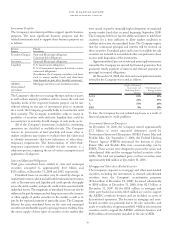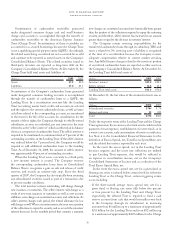American Express 2008 Annual Report Download - page 41
Download and view the complete annual report
Please find page 41 of the 2008 American Express annual report below. You can navigate through the pages in the report by either clicking on the pages listed below, or by using the keyword search tool below to find specific information within the annual report.2008 financial review
american express company
Trust. During February 2009, for certain fixed rate series
within the Lending Trust, a cash reserve account is required
to be funded in the amount of $22 million, of which a partial
funding in the amount of $1.5 million is being recorded in
other receivables on the Company’s Consolidated Balance
Sheets. The Company has rights to this cash, and it will only
be used if this cash is required to help pay-off any outstanding
principal or interest at maturity or in the event of an early
amortization (see below). These fixed rate series, referred to
above, will mature in 2009 and 2011, and it is expected that
the cash in the cash reserve account will revert back to the
Company upon maturity.
• If the three-month average excess spread rate, net for a given
fixed or floating rate series for either Trust falls below zero
percent, an early amortization of the affected Trust will
occur. The applicable cash reserve account (see above) for
each Trust is available to the investors if the collections from
the securitized loans and receivables are insufficient to pay
the principal balance of the investors’ notes and certificates.
• In the event of an early amortization of the Lending Trust,
the lending receivable assets and investor certificates issued
by the Lending Trust would revert to the Company’s balance
sheet and the investor certificates would be required to be
repaid over an approximate four month period, based on the
estimated average life of the securitized loans. Although
the repayment of the investor certificates is non-recourse
to the Company, the Company would need an alternate
source of funding for the lending receivables assets that, as
a consequence of the early amortization, would revert to the
Company’s balance sheet, as well as for lending receivables
assets that would be generated in the future from the
accounts that are the source of the reverted receivables.
• In the event of an early amortization of the Charge
Trust, the underlying investor notes issued by the Charge
Trust are required to be repaid over an approximate one
month period, based on the estimated average life of the
securitized receivables.
• In the event of an early amortization event of either of
the Trusts, obtaining an alternative source of funding of a
commensurate amount would present a severe liquidity
challenge for the Company.
With respect to both the Lending Trust and the Charge Trust,
a decline in the actual or implied short-term credit rating of
TRS below A-1/P-1 would trigger a requirement that TRS, as
servicer, transfer collections on the securitized assets to investors
on a daily, rather than a monthly, basis or make alternative
arrangements with the rating agencies to allow TRS to continue
to transfer collections on a monthly basis. Such alternative
arrangements include obtaining appropriate guarantees for the
performance of the payment and deposit obligations of TRS, as
servicer. No such events have occurred during 2008 and 2007.
No officer, director, or employee holds any equity interest
in either trust, or receives any direct or indirect compensation
from either trust. Neither trust in the Company’s securitization
programs owns stock of the Company or the stock of any
affiliate. Investors in the securities issued by either trust have
no recourse against the Company if cash flows generated from
the securitized assets are inadequate to service the obligations
of either trust.
For additional information about the Company’s asset
securitizations that could affect the Company’s liquidity position
including three-month average excess spread rates, refer to
Note 6 to the Consolidated Financial Statements.
liquidity strategy
The Company seeks to ensure that it has adequate liquidity
in the form of cash and readily-marketable securities easily
convertible into cash, as well as access to cash and equivalents,
to continuously meet its business needs, sustain operations, and
satisfy its obligations for a period of at least 12 months without
access to the unsecured and asset securitization debt capital
markets. This objective is managed by regularly accessing
capital through a broad and diverse set of funding programs, by
maintaining cash and readily-marketable securities, as well as
through a variety of contingent sources of cash and financing.
The Company maintains a liquidity plan that enables it to
continuously meet its daily obligations when its access to
financing becomes impaired or markets become inaccessible.
The plan contemplates a hypothetical 12-month liquidity
crisis occurring as a sudden and unexpected event that makes
financing from its various funding sources unavailable.
The sources of cash in such stress environments include, but
are not limited to, the Company’s cash and readily-marketable
securities, an undrawn committed conduit facility to purchase
securitized credit card receivables, secured borrowing from the
Federal Reserve Bank of San Francisco through the Federal
Reserve discount window and the Term Auction Facility
(TAF), remaining capacity under the TLGP and CPFF
through the period of the programs’ expiration, the sale of
consumer and commercial cardmember receivables, and small
business and consumer loans to private investors through its
existing securitization programs, as well as committed bank
credit facilities. The Company has identified over $80 billion in
alternate sources of cash from these sources.
As a result of the Company’s funding activities during 2008,
the Company raised funds that substantially exceeded its 2008
funding needs. The excess was invested with the purpose of
increasing the amount of cash and readily-marketable securities
the Company holds.
39
























